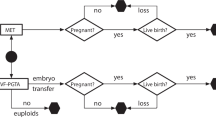Abstract
Purpose
To gain insight into the morphology of the first polar body (1 PB) in ICSI patients and to explore whether it could predict mature oocyte viability and performance in this setting.
Methods
Seventy two consecutive women planned to perform ICSI treatment were prospectively recruited for this study. All oocytes retrieved underwent evaluation for nuclear maturity and accurate assessment of 1 PB morphology. MII oocytes were cultured in separate groups in each woman in accordance with two different categories of 1 PB morphology. Category A included normal intact round or ovoid 1 PB and category B included abnormal fragmented 1 PB. Each oocyte was followed throughout fertilization, embryo cleavage and embryo transfer. Cycles that reached embryo transfer, were divided into three groups in accordance with 1 PB morphology. Group I included only category A 1 PB embryos, group II included categories A and B 1 PB embryos, whereas group III included only category B 1 PB embryos.
Results
A total of 687 oocytes were aspirated and 553 MII oocytes underwent ICSI leading to 410 zygotes showing normal fertilization on day one. Three hundred ninety seven embryos cleaved on day two and a total of 176 embryos were replaced into the uterus. Clinical implantation and pregnancy rates were significantly correlated with the morphology of the 1 PB corresponding to 31%, 9% and 2% and 61%, 24% and 5%, in groups I, II and III respectively.
Conclusions
Our findings demonstrate that 1 PB morphology is related to mature oocyte viability and it has the potential to predict oocyte performance and pregnancy achievement in infertile women undergoing ICSI treatment.

Similar content being viewed by others
References
Scott L. The biological basis of non-invasive strategies for selection of human oocytes and embryos. Hum Reprod Update. 2003;9:237–49.
Eichenlaub-Ritter U, Schmiady H, Kenetenich H, Soewarto D. Recurrent failure in polar body formation and premature chromosome condensation in oocytes from a human patient: indicators of asynchrony in nuclear and cytoplasmic maturation. Hum Reprod. 1995;10:2343–9.
Younis JS, Radin O, Mirsky N, Izhaki I, Majara T, Bar-ami S, et al. First polar body and nucleolar precursor bodies morphology is related to the ovarian reserve of infertile women. Reprod Biomed Online. 2008;16:851–8.
Xia P. Intracytoplasmic sperm injection: correlation of oocyte grade based on polar body, perivitelline space and cytoplasmic inclusions with fertilization rate and embryo quality. Hum Reprod. 1997;12:1750–5.
Ebner T, Moser M, Yaman C, Feichtinger O, Hartl J, Tews G. Elective transfer of embryos selected on the basis of first polar body morphology is associated with increased rates of implantation and pregnancy. Fertil Steril. 1999;72:599–603.
Ebner T, Yaman C, Moser M, Sommergruber M, Feichtinger O, Tews G. Prognostic value of first polar body morphology on fertilization rate and embryo quality in intracytoplasmic sperm injection. Hum Reprod. 2000;15:427–30.
Mikkelsen AL, Lindenberg S. Morphology of in-vitro matured oocytes: impact on fertility potential and embryo quality. Hum Reprod. 2001;16:1714–8.
Verlinsky Y, Lerner S, Illkevitch N, Kuznetsov V, Kuznetsov I, Cieslak J, et al. Is there any predictive value of first polar body morphology for embryo genotype or developmental potential? Reprod Biomed Online. 2003;7:336–41.
De Santis L, Cino I, Rabellotti E, Calzi F, Persico P, Borini A, et al. Polar body morphology and spindle imaging as predictors of oocyte quality. Reprod Biomed Online. 2005;11:36–42.
Chamayou S, Ragolia C, Alecci C, Storaci G, Maglia E, Russo E, et al. Meiotic spindle presence and oocyte morphology do not predict clinical ICSI outcomes: a study of 967 transferred embryos. Reprod Biomed Online. 2006;13:661–7.
Scott L, Finn A, O’Leary T, McLellan S, Hill J. Morphologic parameters of early cleavage-stage embryos that correlate with fetal development and delivery: prospective and applied data for increased pregnancy rates. Hum Reprod. 2007;22:230–40.
Ebner T, Moser M, Sommergruber M, Yaman C, Pfleger U, Tews G. First polar body morphology and blastocyst formation rate in ICSI patients. Hum Reprod. 2002;17:2415–8.
Ciotti PM, Notarangelo L, Morselli-Labate AM, Felleti V, Porcu E, Venturoli S. First polar body morphology before ICSI is not related to embryo quality or pregnancy rate. Hum Reprod. 2004;19:2334–9.
Van Steirteghem AC, Nagy Z, Joris H, Liu J, Staessen C, Smitz J, et al. High fertilization and implantation rates after intracytoplasmic sperm injection. Hum Reprod. 1993;8:1061–6.
Veeck LL. Atlas of the human oocyte and early conceptus, volume 2. Baltimore: Williams & Wilkins; 1991. p. 121–246.
Choi T, Fukasawa K, Zhou R, Tessarollo L, Borror K, Resau J, et al. The Mos/mitogen-activated protein kinase (MAPK) pathway regulates the size and degradation of the first polar body in maturing mouse oocytes. Proc Natl Acad Sci USA. 1996;93:7032–5.
Ortiz M, Lucero P, Coxatto H. Post ovulatory aging of human ova: spontaneous division of the first polar body. Gamete Res. 1983;7:269–76.
Morita Y, Tilly JL. Oocyte apoptosis: like sand through an hourglass. Dev Biol. 1999;213:1–17.
Verlhac MH, Lefebvre C, Kubiak JZ, Umbhaur M, Rassinier P, Maro CW, et al. Mos activates MAP kinase in mouse oocytes through two opposite pathways. EMBOJ. 2000;19:6065–74.
Author information
Authors and Affiliations
Corresponding author
Additional information
Capsule
First polar body morphology is related to mature oocyte viability and it has the potential to predict clinical pregnancy rate in infertile women undergoing ICSI treatment.
Rights and permissions
About this article
Cite this article
Younis, J.S., Radin, O., Izhaki, I. et al. Does first polar body morphology predict oocyte performance during ICSI treatment?. J Assist Reprod Genet 26, 561–567 (2009). https://doi.org/10.1007/s10815-009-9368-9
Received:
Accepted:
Published:
Issue Date:
DOI: https://doi.org/10.1007/s10815-009-9368-9




